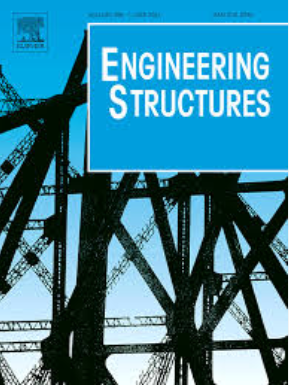Design and instability issues of log-house timber panels under in-plane compression loads
IF 6.4
1区 工程技术
Q1 ENGINEERING, CIVIL
引用次数: 0
Abstract
Log houses are a traditional construction system that is still widely used today for residential homes, vacation cabins, off-grid living, and emergency shelters. While their structural behavior under lateral loads has been extensively studied, in-plane instability under compression due to gravitational loads remains underexplored. Only two modeling approaches have been proposed, both based on classical elasticity theory. However, these models rely on compensatory assumptions or calibrated correction coefficients to approximate actual buckling loads, often leading to significant discrepancies. Log panels share key characteristics with masonry walls: just as masonry has a low tensile strength perpendicular to mortar joints, log panels exhibit weak tensile resistance perpendicular to the grain and at friction-based log-to-log joints. This brittleness causes failure mechanisms similar to those in masonry, where elastic formulations for predicting buckling loads were abandoned since the 1930s in favor of simplified stability models. This study adapts the well-established design approach used for slender masonry walls to log panels by incorporating insights from masonry engineering. The proposed method is developed through an experimental campaign and numerical modeling. The design under in-plane compression, as in masonry, is governed by three key parameters: geometric slenderness, transverse wall stiffening, and load eccentricity. Experimental tests on walls with varying slenderness ratios and load eccentricities have been carried out. Additionally numerical simulations explored the influence of stiffening elements. This research proposes a design framework for log panels under in-plane compression.
平面内压缩荷载作用下木屋木板的设计与失稳问题
木屋是一种传统的建筑系统,今天仍然广泛用于住宅,度假小屋,离网生活和紧急避难所。虽然它们在侧向载荷下的结构行为已经得到了广泛的研究,但由于重力载荷引起的压缩面内不稳定性仍未得到充分的研究。目前只提出了两种基于经典弹性理论的建模方法。然而,这些模型依赖于补偿假设或校准的校正系数来近似实际屈曲载荷,通常会导致显著的差异。原木板与砌体墙具有共同的关键特征:正如砌体具有垂直于砂浆接缝的低抗拉强度一样,原木板在垂直于颗粒和基于摩擦的原木对原木接缝处表现出较弱的抗拉能力。这种脆性导致的破坏机制类似于砌体的破坏机制,自20世纪30年代以来,用于预测屈曲载荷的弹性公式就被抛弃了,取而代之的是简化的稳定性模型。本研究通过结合砖石工程的见解,将细长砖石墙的成熟设计方法应用于原木面板。该方法通过实验和数值模拟得到了发展。面内压缩下的设计,与砌体一样,由三个关键参数控制:几何长细比、横向墙加力和荷载偏心。对不同长细比和荷载偏心的墙体进行了试验试验。此外,数值模拟还探讨了加筋单元的影响。本研究提出了一种平面内压缩条件下原木板的设计框架。
本文章由计算机程序翻译,如有差异,请以英文原文为准。
求助全文
约1分钟内获得全文
求助全文
来源期刊

Engineering Structures
工程技术-工程:土木
CiteScore
10.20
自引率
14.50%
发文量
1385
审稿时长
67 days
期刊介绍:
Engineering Structures provides a forum for a broad blend of scientific and technical papers to reflect the evolving needs of the structural engineering and structural mechanics communities. Particularly welcome are contributions dealing with applications of structural engineering and mechanics principles in all areas of technology. The journal aspires to a broad and integrated coverage of the effects of dynamic loadings and of the modelling techniques whereby the structural response to these loadings may be computed.
The scope of Engineering Structures encompasses, but is not restricted to, the following areas: infrastructure engineering; earthquake engineering; structure-fluid-soil interaction; wind engineering; fire engineering; blast engineering; structural reliability/stability; life assessment/integrity; structural health monitoring; multi-hazard engineering; structural dynamics; optimization; expert systems; experimental modelling; performance-based design; multiscale analysis; value engineering.
Topics of interest include: tall buildings; innovative structures; environmentally responsive structures; bridges; stadiums; commercial and public buildings; transmission towers; television and telecommunication masts; foldable structures; cooling towers; plates and shells; suspension structures; protective structures; smart structures; nuclear reactors; dams; pressure vessels; pipelines; tunnels.
Engineering Structures also publishes review articles, short communications and discussions, book reviews, and a diary on international events related to any aspect of structural engineering.
 求助内容:
求助内容: 应助结果提醒方式:
应助结果提醒方式:


